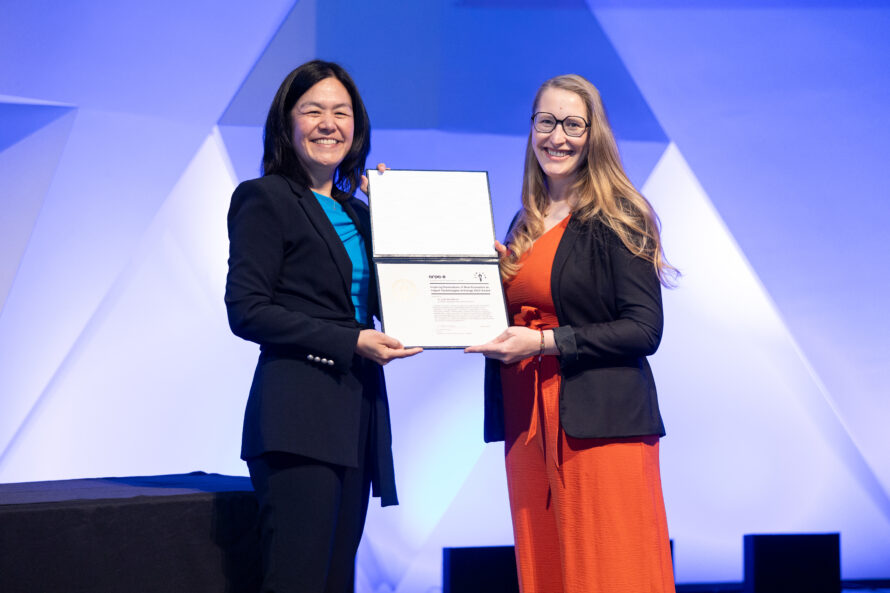Cat Adams
Biologist Research Scientist
Biography
Cat Adams is a fungal ecologist interested in how chemistry such as toxins, light, or fragrances drive interactions between fungi and other living things. She earned her BS from the University of Washington in Biology with emphasis on Ecology and Evolution. For her Master’s at Harvard she studied how fungal seed pathogens of wild chili peppers evolved tolerance to spice. Her PhD at Cal examined the role of toxins in the invasion success of the death cap mushroom, Amanita phalloides. Her postdoctoral research examined how fragrances made by a plant root-associated fungus impact their friendly neighborhood bacteria. Cat is excited to join the Northen lab and learn more about mycorrhizal fungi!
Cat also enjoys embroidery, acrylic pour painting, and metal music.
Research Interests
Chemistry, ecology, fungi, mushrooms, signalling, soil, and toxins.
Recent Publications
Research Interests
Piya is a team member of the DOE BRaVE-funded Phage Foundry project for systematic characterization of phages and phage-tail like bacteriocins as a powerful countermeasure to tackle the antimicrobial resistance pandemic. He is currently interested in identifying factors that modulate interactions between phages and pathogenic bacteria so that machine learning tools can be employed to predict interaction between novel phages and their bacterial hosts. He is applying CRISPR and Dubseq technologies to study how genes affect fitness in the context of phage infection.
Recent Publications
Recent Publications
Related News
A New Genetic Hallmark for Predicting Breast Cancer Outcomes
Biosciences researchers have used Collaborative Cross mice, a mouse model system designed to mimic the diversity of human populations, to identify a set of genetic factors that could help refine treatment approaches for a fast-growing form of breast cancer.
Infrared and AI Detect Low-dose Radiation Long After Exposure
Biosciences researchers have established a powerful new method that couples advanced infrared imaging techniques with statistical machine learning models to quickly and non-invasively determine with high accuracy whether an animal was exposed to radiation—even at extremely low doses almost three months post exposure.
Toward a Genetic Understanding of Variability in Radiation Sensitivity
Injury to immune-system and blood-forming cells is a common side effect of radiation therapy, which more than half of all cancer patients receive as part of their treatment. Biosciences Area researchers and their collaborators used a genetically diverse mouse population to model individual differences in sensitivity to radiation exposure.
Divisions
- Science Programs
Secondary Affiliation:
Environmental Genomics and Systems Biology
- Comparative and Functional Genomics
Research Interests
Plant roots excrete a variety of metabolites into the rhizosphere and create unique habitats for the microbial communities. The microbes exchange their metabolites and significantly impact plant physiology through symbiosis and virulence. Recent metagenomic studies have expanded the catalog of genomic information of the microbiome across diverse plant species and soil environments. However, much less is studied about the molecular mechanisms underlying the formation of these microbial ecosystems. To understand the basis of plant-microbial interactions, my research focuses on developing novel experimental approaches and identifying the quantitative links from genotype to phenotype. I will combine a careful characterization of rhizobacterial physiology with a spectrum of advanced capabilities at Berkeley Lab, including functional genomics, genome engineering, and laboratory automation.
Recent Publications
No publications are available at this time.
Related News
Biosciences FY25 LDRD Projects
The projects of 23 Biosciences Area scientists and engineers received funding through the FY25 Laboratory Directed Research and Development (LDRD) program.
Biosciences Area FY24 LDRD Projects
The projects of 21 Biosciences Area scientists and engineers received funding through the FY24 Laboratory Directed Research and Development (LDRD) program.
Research Interests
Research areas include CO2 bioconversion, carbon optimized biological systems, hydrogen biotechnology, and sustainable aviation fuels.
Recent Publications
Divisions
Earth & Environmental Sciences Area
Secondary Affiliation:
Environmental Genomics and Systems Biology
- Molecular EcoSystems Biology
Research Interests
Kolby Jardine studies plant and microbial metabolism by working at the interface of biochemistry, ecology, and atmospheric sciences (Biochemical Ecology).
The primary goal of the research is to characterize quantitative relationships between biochemical, optical, and volatile organic signals emitted by plants during climate extremes in order to characterize processes and mechanisms of potentially high global importance. This presents exciting opportunities for the development of new methods for the continuous local and global monitoring of the physiological, energetic, and oxidative status of plants and ecosystems and their associated cycling of carbon and water.
Field, greenhouse, and laboratory methods are developed for the quantification of carbon dioxide and gas-phase volatile organic compound concentrations, fluxes, and isotopic composition from leaves to ecosystems and seconds to seasons. Methods include IR spectrometry, proton transfer reaction mass spectrometry (PTR-MS), and thermal desorption-gas chromatography-mass spectrometry (TD-GC-MS).
Recent Publications
Related News
Bioscientists to Receive DOE Funding for Biomanufacturing and Microbiome Research
Biosciences researchers are among the recipients of four new DOE awards. Two awards will focus on reducing carbon emissions while producing bioenergy. The other two are aimed at understanding the role of microbiomes in the biogeochemical cycling of elements like carbon.
Research Interests
Professor Schepartz’s research group is interested in questions that span the chemistry-biology continuum. We seek to establish new knowledge about the chemistry of complex cellular processes and apply this knowledge to design or discover molecules–both small and large–with unique or useful properties. We apply the tools of organic synthesis, biochemistry, biophysics, and structural, molecular, and synthetic biology in our work. Current projects focus on (1) repurposing the ribosome to biosynthesize sequence-defined chemical polymers and polyketides; (2) exploring and improving novel tools for trafficking proteins to the cytosol and nucleus for therapeutic applications; (3) understanding the mechanism by which chemical information is transported through cellular membranes; and (4) developing new probes and fluorophores to image organelle dynamics at super-resolution for highly extended times and in multiple colors.
Recent Publications
Biography
Lydia holds a bachelor’s degree in Food Science & Biotechnology, a master’s degree in Biotechnology, and a Ph.D. in Environmental Microbiology from the University of Natural Resources and Life Sciences, Vienna. She completed her first postdoctoral training at the Bioenergy and Sustainable Technologies research center in Austria, and joined Berkeley Lab in 2019 for her second postdoc at the Joint Bioenergy Institute (JBEI) before transitioning to her current scientist role.
Research Interests
Specializing in anaerobic microbiology and sustainable bioenergy research, her work centers on harnessing anaerobic microbial communities to transform a variety of waste streams—including marine seaweed, industrial residues, and syngas—into renewable fuels, chemicals, and biomanufacturing products.
Lydia’s research advances sustainable solutions for bioenergy and decarbonization. She leads projects that bridge fundamental microbial ecology, bioprocess development, and scalable biomanufacturing.
- Anaerobic microbiology
- Environmental microbiome
- Gas fermentation
- Adaptive laboratory evolution
- Bioprocess development
- Biomanufacturing
Programs & Initiatives

Imagine a world where waste carbon emissions are transformed into sustainable aviation fuels, dramatically reducing our carbon footprint and reducing our dependence on fossil fuel imports.
The ARPA-E funded IGNIITE project aims to develop a scalable and sustainable carbon conversion process to minimize greenhouse gas emissions in the aviation sector. The approach leverages the microbial conversion of waste-derived syngas into carboxylic acids as a precursor for sustainable aviation fuels.

Lydia Rachbauer, a postdoctoral researcher at the Joint BioEnergy Institute (JBEI) in the Biosciences Area’s Biological Systems and Engineering Division was selected for first place and people’s choice prizes in the inaugural Bay Area Research SLAM competition on October 28. Rachbauer delighted the audience and judges with her three-minute story on utilizing the microbes found in fish guts to convert seaweed into sustainable biofuels.
Recent Publications
Related News
Biosciences FY25 LDRD Projects
The projects of 23 Biosciences Area scientists and engineers received funding through the FY25 Laboratory Directed Research and Development (LDRD) program.
Biosciences Area FY24 LDRD Projects
The projects of 21 Biosciences Area scientists and engineers received funding through the FY24 Laboratory Directed Research and Development (LDRD) program.
Rachbauer Wins First Place at Bay Area Research SLAM Competition
Lydia Rachbauer, a postdoctoral researcher at the Joint BioEnergy Institute (JBEI) in the Biosciences Area’s Biological Systems and Engineering Division was selected for first place and people’s choice prizes in the inaugural Bay Area Research SLAM competition on October 28. Rachbauer delighted the audience and judges with her three-minute story on utilizing the microbes found in fish guts to convert seaweed into sustainable biofuels.
Research Interests
The role of microorganisms in the rhizosphere priming of soil organic matter decomposition
I am interested in physiological, biochemical and evolutionary aspects of plant-microbial interactions and how these interactions mediate biogeochemical cycles. Plant-soil-microbial crosstalk is operated through complex nutrient exchanges, where plant-released exudates can be consumed by rhizosphere communities. This can mediate microbial metabolism triggering microbial response that may be involved in nutrient stabilization/destabilization in soils – rhizosphere priming. I am using genomic analysis of a rhizosphere community to define metabolic traits that outline mutualistic relationships between microorganisms and plants in soil (e.g. extracellular enzymes, nutrient transporters). I am also using exometabolomic analysis and profiling of exoenzymes activities to evaluate what microbes uptake from the plant-exuded compounds, and how they respond to the plant exudation through release of metabolites and changing exoenzymatic activities.
Recent Publications
Related News
Plants Use Signaling Molecules to Fine-tune Their Microbiomes
Researchers have identified several key compounds that shape the microbial communities dwelling around plant roots and soil, opening up the possibility for agricultural strategies that precisely and sustainably improve plant health and crop yields. One such compound was serotonin, a signaling molecule commonly known for its role in mood regulation. In this context, serotonin was found to enhance plant growth and shape microbial communities living around plant roots under nutrient-rich conditions.
Biosciences FY25 LDRD Projects
The projects of 23 Biosciences Area scientists and engineers received funding through the FY25 Laboratory Directed Research and Development (LDRD) program.
EcoFAB: A Tool for Combating Climate Change and Training the Next Generation
Fabricated ecosystems—EcoFABs—are plastic, takeout box–sized growth chambers developed at Berkeley Lab to be a standardized and reproducible platform for conducting experiments on model plants and the microbes that live around their roots. A greater understanding of how plants and microbes work together to store vast amounts of atmospheric carbon in the soil will help in the design of better bioenergy crops for the fight against climate change.

Building: 091, Room 0250C
Mail Stop: Donner
Phone: 510-486-7106
Fax: 510-486-7080
AGaudin@lbl.gov
https://gaudin.ucdavis.edu/
Research Interests
We explore how diversification and healthy soil ecosystems can help agriculture meet its sustainability and resilience goals. We integrate concepts and methodologies from various disciplines to measure outcomes of ecological intensification strategies and linkages between diversification, soil health and ecological resilience. We also study plant-microbe interactions in the rhizosphere and the ecological functions central to crop production in agroecological systems.
Recent Publications
Related News
UC Davis, Berkeley Lab Team up to Advance Green Agriculture
Three University of California, Davis, Faculty Fellows have been awarded $25,000 each to spearhead cross-campus research projects with Berkeley Lab scientists in the field of agricultural decarbonization. With agricultural activities contributing over 10% of the United States’ total greenhouse gas emissions, the sector is a prime target for lowering emissions and addressing the climate crisis. The teams will explore innovative methods to remove and store excess carbon dioxide from the atmosphere—a practice known as carbon sequestration—and minimize energy consumption in crop production.
Research Interests
functional genomics, in vivo transgenic mouse assay
Programs & Initiatives
Recent Publications
Related News
AI Helps Decode Gene Regulation
A combination of comprehensive experiments and machine learning is uncovering hidden complexities of gene expression during development.
Biosciences FY25 LDRD Projects
The projects of 23 Biosciences Area scientists and engineers received funding through the FY25 Laboratory Directed Research and Development (LDRD) program.
Divisions
- Science Programs
Secondary Affiliation:
Environmental Genomics and Systems Biology
- Comparative and Functional Genomics
Research Interests
The plant microbiome includes beneficial microbiota that provide the plant host protection from pathogens, increased nutrient availability and resilience against abiotic stress. Prior investigations of plant microbiomes have mainly focused on bacteria and fungi while largely ignoring viruses, the most abundant biological entities on the planet. In consequence, the prevalence and function of phages (viruses infecting bacteria) in the plant microbiome remain poorly understood. At the DOE Joint Genome Institute, my research broadly focuses on plant-microbial interactions. Specifically, I am currently investigating the quantitative impact of phage genes on root colonization and the molecular underpinnings of a presumptive plant-bacterial-phage interaction.
Recent Publications
Related News
Biosciences Area FY24 LDRD Projects
The projects of 21 Biosciences Area scientists and engineers received funding through the FY24 Laboratory Directed Research and Development (LDRD) program.














